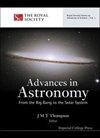Forecasting Ionospheric TEC Changes Associated with the December 2019 and June 2020 Solar Eclipses: A Comparative Analysis of OKSM, FFNN, and DeepAR Models
IF 1.2
4区 物理与天体物理
Q3 ASTRONOMY & ASTROPHYSICS
引用次数: 0
Abstract
This paper presents forecast and investigation of the variation in ionospheric Total Electron Content (TEC) during the solar eclipses (SEs) of December 2019 and June 2020 using three different methods: Deep Autoregressive model (DeepAR), Feed-Forward Neural Network (FFNN), and Ordinary Kriging-based Surrogate Model (OKSM), and the TEC data predicted by DeepAR, FFNN, and OKSM were compared with the actual TEC during the observation days. The study was conducted based on GPS data taken from the IISC receiver located in Bangalore, India, during the SEs which happened on 26.12.2019 and 21.06.2020. The TEC data were examined to assess the effect of solar eclipses on TEC values. Eighty-day prior TEC data for the IISC station are gathered from IONOLAB servers along with the other parameter data like Dst, Ap, F10.7, and Kp taken from OMNIWEB servers which were used to predict TEC. The reliability of the forecasted results is evaluated using numerical factors like Normalized Root Mean Square Error (NRMSE), Correlation Coefficient (CC), Root Mean Square Error (RMSE), Mean Absolute Error (MAE), and R-squared. The study demonstrates the usefulness of combining multiple methods for analyzing TEC variations during SEs and highlights the potential of OKSM, FFNN, and DeepAR models for studying TEC variation in the same context. The findings may be useful for satellite broadcasting and navigational services and for further research into the influence of solar eclipses on the TEC changes.预测与 2019 年 12 月和 2020 年 6 月日食相关的电离层 TEC 变化:OKSM、FFNN 和 DeepAR 模型的比较分析
本文采用三种不同的方法对2019年12月和2020年6月日食期间电离层总电子含量(TEC)的变化进行了预测和研究:深度自回归模型(DeepAR)、前馈神经网络(FFNN)和基于普通克里金的代理模型(OKSM),并将DeepAR、FFNN和OKSM预测的TEC数据与观测日期间的实际TEC进行了比较。该研究基于位于印度班加罗尔的 IISC 接收机在 2019 年 12 月 26 日和 2020 年 6 月 21 日 SE 期间采集的 GPS 数据。对 TEC 数据进行了检查,以评估日食对 TEC 值的影响。从 IONOLAB 服务器收集了 IISC 站前 80 天的 TEC 数据,以及从 OMNIWEB 服务器收集的其他参数数据,如 Dst、Ap、F10.7 和 Kp,用于预测 TEC。预测结果的可靠性通过归一化均方根误差 (NRMSE)、相关系数 (CC)、均方根误差 (RMSE)、平均绝对误差 (MAE) 和 R 平方等数值因子进行评估。该研究证明了结合多种方法分析 SE 期间 TEC 变化的实用性,并强调了 OKSM、FFNN 和 DeepAR 模型在同一背景下研究 TEC 变化的潜力。研究结果可能对卫星广播和导航服务以及日食对 TEC 变化影响的进一步研究有用。
本文章由计算机程序翻译,如有差异,请以英文原文为准。
求助全文
约1分钟内获得全文
求助全文
来源期刊

Advances in Astronomy
ASTRONOMY & ASTROPHYSICS-
CiteScore
2.70
自引率
7.10%
发文量
10
审稿时长
22 weeks
期刊介绍:
Advances in Astronomy publishes articles in all areas of astronomy, astrophysics, and cosmology. The journal accepts both observational and theoretical investigations into celestial objects and the wider universe, as well as the reports of new methods and instrumentation for their study.
 求助内容:
求助内容: 应助结果提醒方式:
应助结果提醒方式:


